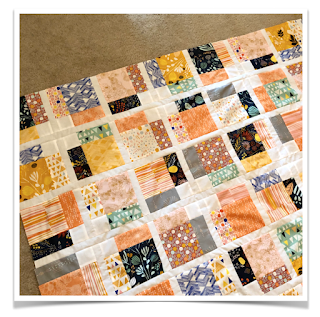I've never sewn with flannel before, but it's surprisingly easy to work with. Flannel has a brushed surface with a nap to it. When I pressed my piecing I would first lay down another piece of flannel right side up on my ironing board and then lay my fabric right side down to that, pressing nap to nap. This preserves the loft of the brushed surface of the flannel.
I didn't have a pattern for this quilt. Basically, I just put sashing and squares around the gnome panel. Once these joyful little gnomes were stitched together I loaded them onto my longarm.
This quilt has a fun flannel backing filled with frolicking gnomes. The backing is cute all on its own!
I used Warm and Natural Cotton Batting for this quilt. I used MicroQuilter #7007 - Silver thread for the top and in the bobbin I used So Fine #401 - White. I used a stitch length of 8 and I played around with the machine speed because the sewhead seemed to drag a bit with the heavier flannel.
I used a 3.5 tension and a 180 TOWA tension for the bobbin. I started with an 80/12 Topstitch needle but I was getting skipped stitches now and then. Again, the flannel top and bottom made this heavier to sew through so I switched out to a larger Titanium 90/14 Topstitch needle from Superior Threads and that seemed to solve the problem.
When it was all done I made binding in a red and white striped flannel and sewed that all the way around. I had one of those dreaded moments that quilters have when I realized I was just short of the fabric I needed to finish the binding. Etsy to the rescue! I ordered a fat quarter and finished it up!
It was the cutest little binding ever! Here is it on the Binding Baby. Binding Baby's are used to roll up the long binding and keep it off the floor and out of the way as you stitch it to the quilt top.
I'm still wearing a brace on my hand. I have a sturdier one that I wear around the house but when I quilt I take that one off and use this one with the flexible thumb. I'm also still using the Palm Precision Handles without using the red side button in order to not use my thumb at all. Hopefully, my thumb will get better soon.
I just love the little gnomes on this snowflake quilt! We have a little gnome in our garage named Pukii. Pukii's job is to keep the coyotes out of the garage! He was nice enough to pose with the quilt!
This is a great little quilt to snuggle with. I hope my brother and his wife like it and share it with their grandson when he comes to visit them!
Remember to pick up a needle and thread and stitch some love into your world❣️




















































